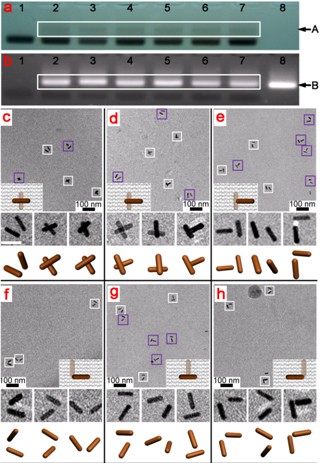Well-defined plasmonic nanoarchitectures are of great significance in the study of plasmon-enhanced singlemolecule spectroscopy, plasmonic chiral optics,nanophotonic and nanoelectronic devices,etc. 3D plasmonic nanoarchitectures with precise control of particle size, interparticle distance, and geometric configuration may exhibit novel optical, electronic, and magnetic properties, which are rarely realized in 1D and 2D nanostructures. In particular, rational organization of anisotropic metallic building blocks in 3D space may result in plasmonic chiral optical properties, which have been studied theoretically, for instance, in plasmonic nanorod assemblies. To date, in bottom-up construction of 3D plasmonic nanoarchitectures, spherical nanoparticles are mostly used because their isotropic nature facilitates unoriented localization. In the case of 3D nanoarchitectures composed of anisotropic building blocks, only examples of gold nanorod (AuNR) supra-aggregates lacking precise spatial control have been reported. Directed assembly of anisotropic metallic building blocks into discrete and tailored 3D plasmonic nanoarchitectures still remains challenging. Unlike spherical metallic nanoparticle assemblies, for which the understanding of plasmonic chirality on the basis of plasmon hybridization theory is well-established, examples of discrete 3D anisotropic building block nanoarchitectures displaying chiral optical activity are scarce.
Prof. Wang Qiangbin’s group from Suzhou Institute of Nano-Tech & Nano-Bionics, CAS, has reported the first example of of discrete 3D AuNR dimers with controlled interparticle distance and spatial orientation by precisely assembling the AuNRs on opposite sides of a rectangular bifacial DNA origami. (J. Am. Chem. Soc., 2013, 135 (31),11441–11444).Tuning the docking position of the AuNRs on the bifacial DNA origami allowed the 3D spatial configuration of the obtained plasmonic nanoarchitectures to be manipulated well. The chiroptical activity was significantly modulated by rational design of the geometry and spatial arrangement of the assembled 3D AuNR nanoarchitectures. It was found that the DNA origami plays the dominant role in determining the chiral response of the symmetric 3D AuNR dimer nanoarchitectures. In contrast, structural chirality dominates the chiroptical activity of the asymmetric nanoarchitectures.
This work was supported by “Hundred Talents” program of CAS, Strategic Priority Research Program of CAS, NSFC, NSFJP (BK2012007), the CMST (2011CB965004), and CAS/SAFEA International Partnership Program for Creative Research Teams.

Figure1. Characterization of the as-obtained 3D AuNR dimer nanoarchitectures. (a, b) SYBR Green-stained agarose gels of the AuNR dimer nanoarchitectures assembled on the bifacial DNA origami taken under (a) daylight and (b) UV light. Lane 1, 11 nm × 37 nm AuNRs. Lanes 2−7: AuNR dimers X1, X2, T1, L1, T2, and L2, respectively. Lane 8: purified rectangular bifacial origami. (c−h) Cryo-EM images of 3D AuNR dimer nanoarchitectures assembled on bifacial DNA origami (top row), close-up views of white-boxed structures (middle row), and corresponding model structures with specific orientations (bottom row): (c) X1; (d) X2; (e) T1; (f) L1; (g) T2; (h) L2. The scale bar in the high magnification image is 40 nm.(Image by SINANO)

Figure2. CD spectra of the discrete 3D plasmonic AuNR dimer nanoarchitectures: (a) X1, X2, and T1; (b) L1, T2, and L2. The concentrations of all of the samples were the same.(Image by SINANO)

